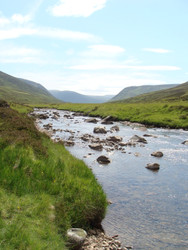Cairngorms National Park & Wild Camping | Dallaswear
Posted by Callum McCrimmon on 1st Jan 1970
Cairngorms National Park And Wild Camping
The Cairngorms National Park is the UK’s largest National Park and located in the Highlands of Scotland.
One third of the land within the Park is above 600 metres and is home to one quarter of Scotland’s native trees. It also has more breeding waders than the whole of Wales. A quarter of the UK’s endangered species live within the park. And, I can tell you after many visits to the area, that the scenery is absolutely stunning. I always take a pair of binoculars with me and have been luck enough to see Golden Eagles quite regularly. On one occasion I even saw a golden eagle take a rabbit. It was an amazing experience. Other animals that are present in the area include Capercaillie, Pine Marten, Red Squirrels and Snow Bunting.
What is wild camping?
Wild camping, basically, is pitching a tent in the wilderness. Camping in a farmer’s field, a festival or your back garden, although fun, is not wild camping. With wild camping you can be totally alone, you can get away from busy campsites and really enjoy all that nature has to offer in its’ raw form. Imagine waking up on a beautiful beach with just the sound of the waves breaking and the gulls overhead or in the mountains, to the sound of silence.
Wild camping in Scotland
Scotland has right-to-roam rules and the 2003 Land Reform Act (Scotland) which allows the public to camp on most unenclosed land. This policy includes many of Scotland’s National Parks making them a magnet for wild campers.
Wild camping, therefore, is legal in most of Scotland. It is advisable, however, to check your chosen camping spot with the relevant authorities before arriving because there are some exceptions. There are certain areas around Loch Lomond, for example, where it is now forbidden because of the bad behaviour of campers who proved a nuisance to local people and did not clear up after themselves.

Wild camping is largely illegal in England and Wales, although it is allowed in parts of the Lake District and Dartmoor National Park. Having said that, many landowners will allow wild camping on their land but of course you need their permission and you need to respect their land by tidying up afterwards and leaving the site as you found it. A leave no trace policy is adopted and encouraged by wild campers.
Wild camping is ideal for hikers who wish to stay in the countryside overnight. Travelling light is key to the experience. There are tents available that are near indestructible and weigh hardly anything. It is advisable to do your research before heading out for your first wild camping experience. There are lots of things to take in to consideration. If you are heading deep in to the wilderness you will need to know what and how much food to take. Research the best way to store your food and water supplies. Obviously the deeper in to the wilderness you go, the fewer facilities there are. Inevitably you will need to consider your toiletry needs. The Cairngorm National Park has a very good website with lots of tips readily available that covers practicalities like this, giving the best advise for an enjoyable experience with little or no impact on the environment. There are links to the Scottish Outdoor Access Code which should tell you all you need to know. The website also has full details of all types of accommodation within the Cairngorms National Park ranging from campsites, hostels, hotels, log cabins and B&B’s.

As with all aspects of life at the moment social distancing measures are still in place due to Covid 19 and any accommodation should be booked in advance. It is also advisable to check with activity providers, restaurants and cafes for availability at this time and their opening hours.
If you can’t make it to the Park at the moment The Cairngorms National Park website has a section which allows you to observe the wildlife of the area from the comfort of your own armchair.


